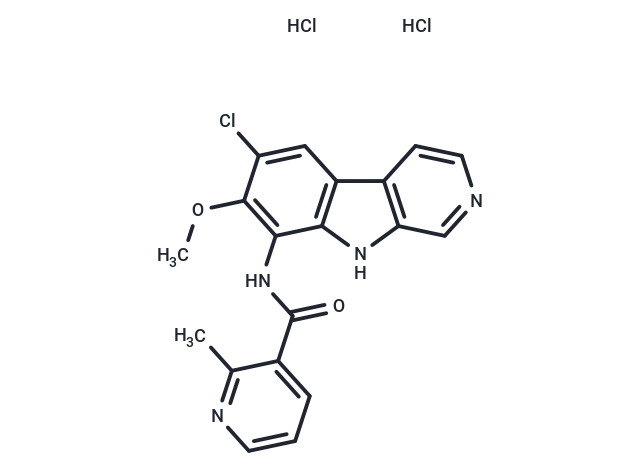Shopping Cart
Remove All Your shopping cart is currently empty
Your shopping cart is currently empty
MLN120B dihydrochloride (ML120B dihydrochloride) is a highly potent, orally active inhibitor of IKKβ, competitively binding to ATP with an IC50 value of 60 nM, effectively suppressing the growth of multiple myeloma cells in vitro and in vivo, and valuable in rheumatoid arthritis research.

| Pack Size | Price | USA Warehouse | Global Warehouse | Quantity |
|---|---|---|---|---|
| 2 mg | $88 | 5 days | 5 days |
| Description | MLN120B dihydrochloride (ML120B dihydrochloride) is a highly potent, orally active inhibitor of IKKβ, competitively binding to ATP with an IC50 value of 60 nM, effectively suppressing the growth of multiple myeloma cells in vitro and in vivo, and valuable in rheumatoid arthritis research. |
| In vitro | MLB120B, at concentrations ranging from 0-20 μM administered over 90 minutes, suppresses the phosphorylation and degradation of IκB in RPMI 8226 and INA6 cells, though it does not show significant inhibition in MM.1S cells. Additionally, at concentrations between 1.25-20 μM for the same duration, MLB120B effectively halts TNF-α-induced phosphorylation and degradation of IκB in a dose-dependent manner, also blocking TNF-α-induced phosphorylation of p65 NF-κB. The compound inhibits the proliferation of multiple myeloma cell lines, including MM.1S, MM.1R, RPMI 8226, RPMI-LR5, RPMI-Dox40, U266, and INA6, displaying 5% to 50% inhibition at doses above 20 μM and 18% to 70% inhibition measured by [3H]thymidine uptake. Further, MLB120B (1.25-40 μM; 72 hours) significantly impedes the stimulation of growth in MM.1S, U266, and INA6 cells and IL-6 secretion from bone marrow stromal cells (BMSCs) induced by the adherence of multiple myeloma cells to BMSCs. The compound also demonstrates inhibition of LPS-induced NF-κB activation in RAW267.4 cells, with IC50 values of 1.4 μM, 14.8 μM, and 27.3 μM for NF-κB2-luc2, IL8-luc2, or TNF-AIP3-luc2 reporter transfected cells, respectively. Western Blot Analysis shows that MLB120B inhibits p-IκB and p-P65 expression in a dose-dependent manner in MM.1S cells at 5 μM, 10 μM, and 20 μM concentrations over 90 minutes. The Cell Viability Assay further confirms that MLB120B inhibits the proliferation of multiple myeloma cell lines across a 0-40 μM concentration range over 72 hours. |
| In vivo | MLN120B, administered orally at a dosage of 50 mg/kg twice daily for three weeks, has been shown to significantly reduce shuIL-6R, a key marker of tumor growth, in two separate studies, thereby indicating its efficacy in suppressing tumor progression. Furthermore, this treatment has demonstrated a trend towards prolonged survival in treated animals when compared to controls, suggesting its potential therapeutic benefit in oncological contexts[1][3]. Implemented in an animal model involving SCID mice implanted with human fetal bone chips and subsequently inoculated with INA6 cells, MLN120B inhibited human multiple myeloma cell growth in vivo. Additionally, in a study with two-month-old female Lewis rats administered varying dosages (30 mg/kg, 10 mg/kg, 3 mg/kg, or 1 mg/kg) of MLN120B orally twice daily for three weeks, it was found to protect against bone and cartilage destruction in a rat model of disease, further evidencing its potential for broader applications in disease treatment and management[2]. |
| Synonyms | ML120B dihydrochloride |
| Molecular Weight | 439.72 |
| Formula | C19H17Cl3N4O2 |
| Cas No. | 1782573-78-7 |
| Storage | Powder: -20°C for 3 years | In solvent: -80°C for 1 year | Shipping with blue ice/Shipping at ambient temperature. |
| Size | Quantity | Unit Price | Amount | Operation |
|---|

Copyright © 2015-2025 TargetMol Chemicals Inc. All Rights Reserved.